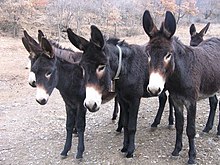Catalan donkey

Catalan donkey
|
|
| Other names |
|
|---|---|
| Country of origin | Spain, France |
| Distribution |
|
| Traits | |
| Height |
|
| Classification | |
| MAPA (Spain) | Breed standard |
|
|
The Catalan donkey (Catalan: Ase Català or Ruc Català; Eastern Catalan: [ˈruk kətəˈɫa], Western Catalan: [ˈruk kataˈla]; Spanish: Asno Catalán) is a breed of large domestic donkey from Catalonia, in north-eastern Spain and south-western France. Approximately 80% of the population is in Catalonia, and approximately 20% is in the historic Roussillon region of France.
Some authors believe the Catalan donkey to be related to the donkey of Mallorca and the Zamorano-Leonés donkey. The breed is considered to be very old;Pliny the Elder mentioned that there were donkeys on the plain of Vic (Osona).
The Catalan donkey originates in the basins of the Cardener, Segre and Ter rivers. In the past it was very important on farms but due to declining use and numbers the Catalan donkey was in danger of extinction. There were once as many as 50,000.
A herd-book was established in 1929. Numbers fell during the Spanish Civil War, but recovered in the next decade. In the 1960s and 1970s rural depopulation and the mechanisation of agriculture led to a new decline in numbers. A breeders' association, the Associació pel Foment de la Raça Asinina Catalana, was formed in 1978 and the herd-book re-opened. Much of the credit for the recovery of the breed is given to one person, Joan Gassó i Salvans from the comarca of Berguedà. In 2004, 32% of the registered population of 336 were on his finca in Olvan. An official national genealogical herd-book was opened in 2002. At the end of 2013 the total population in Spain was recorded as 851. The Ministerio de Agricultura, Alimentación y Medio Ambiente, the Spanish ministry of agriculture, lists the breed as "in danger of extinction".
...
Wikipedia
